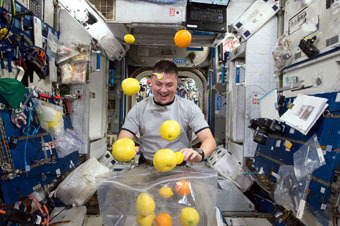
Juggling Weightless Citrus in Space
| published October 20, 2015 |
By Thursday Review staff
Even fresh fruit and veggies have a way of wandering when in space, and the process of gathering and containing them can be somewhat like herding cats. In this photo, taken by NASA astronaut Scott Kelly, U.S. astronaut Kjell Lindgren attempts to bag up food which had been recently delivered to the International Space Station by way of the Kounotori 5 H-II Transfer Vehicle, also known as the HTV-5. Cargo spacecraft sent to rendezvous with the space station often carry a small stockpile of fresh fruits, vegetables and other food products to supplement the food already on board.
The food most commonly used aboard the space station is designed to have a reliably long shelf life, as well as provide maximum efficiency, safety, and ease-of-use in the weightless environment. Foods which produce crumbs, dust, or have loose surface elements—such as salt or pepper—are restricted or banned altogether inside the space station: such foods may produce debris which will eventually get drawn into the ventilation systems or contaminate valuable equipment. Salt and pepper are provided in a unique liquid form to eliminate such dangers.
On the other hand, astronauts are able to eat a diet rich in foods already found in their natural state or traditional form: nuts, berries, cereals, candy bars, energy bars, anything which will not easily produce crumbs or micro-debris. Tortilla and pita bread is used instead of regular loaf bread, since traditional bread not only consumes lots of space, but also produces crumbs. Astronauts and cosmonauts also eat a variety of vegetables and meats in pre-prepared forms, including chicken, beef and seafood.
In this photo, Lindgren is attempting to wrangle citrus products, including oranges, grapefruits and lemons.
Related Thursday Review articles:
A New Record for Time in Space; Thursday Review staff; Thursday Review; October 16, 2015.
Biomedical Experiments in Space; Keith H. Roberts; Thursday Review; August 6, 2015.
